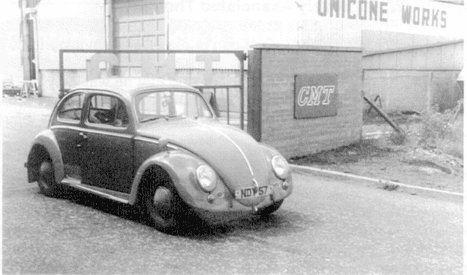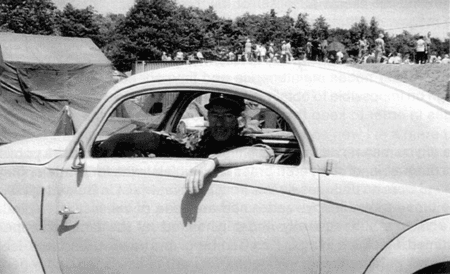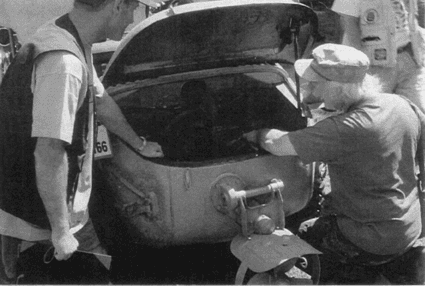Random VW & Loosely Associated Thoughts
by Martin Southwell
It's been a long time since I've put pen to paper with anything to do with VW's, a fact that hadn't escaped Mike Johnson's notice, so when speaking to him recently, he pointed this out, stressing that he was only doing the Editor's job for next year, so could I contribute something ASAP please? OK then Mike, here goes, but firstly I want to share some random thoughts with the long suffering membership.
Like many of the club members, my interest in Ws stems back over a long time, in my case, since the mid 1970's, and even then, there are those who have been around even longer, and still feel that I'm something of a relative newcomer. Fortunately, as Geoff Sumpter keeps pointing out, I still have my first Beetle, as he has been trying for years to locate his first, without any success. (It's been scrapped Geoff - Just admit it!).
NDY 57 is a 1959 de-luxe model, which left the factory resplendent in Garnet Red, although hand painted green for the last 20 years of it's life, as a result of lending the car to my father, who couldn't stand being the centre of attention whilst driving this car of many colours. Unsurprisingly, the car seems to have always been known as Noddy, but at that stage in it's life, it should have been renamed Joseph. Anyway, also adding to the cars 'ambience', and my father's embarrassment, were pieces of Fablon on both sides, covering the fresh air patches where there had previously been rear lower'/4 panels. To prove the point, see the picture of the car sitting outside the Glasgow HQ of CMT, the company I worked for at that time, photographic proof for those I worked with in their Bristol office, who didn't believe the car would get me to Scotland and back!
Like many of the club members, my interest in Ws stems back over a long time, in my case, since the mid 1970's, and even then, there are those who have been around even longer, and still feel that I'm something of a relative newcomer. Fortunately, as Geoff Sumpter keeps pointing out, I still have my first Beetle, as he has been trying for years to locate his first, without any success. (It's been scrapped Geoff - Just admit it!).
NDY 57 is a 1959 de-luxe model, which left the factory resplendent in Garnet Red, although hand painted green for the last 20 years of it's life, as a result of lending the car to my father, who couldn't stand being the centre of attention whilst driving this car of many colours. Unsurprisingly, the car seems to have always been known as Noddy, but at that stage in it's life, it should have been renamed Joseph. Anyway, also adding to the cars 'ambience', and my father's embarrassment, were pieces of Fablon on both sides, covering the fresh air patches where there had previously been rear lower'/4 panels. To prove the point, see the picture of the car sitting outside the Glasgow HQ of CMT, the company I worked for at that time, photographic proof for those I worked with in their Bristol office, who didn't believe the car would get me to Scotland and back!

The car was purchased as a rusty wreck, no doubt as it had been a ‘seaside' car, originally coming from Hastings, where it had probably lived on the sea front for the first ten years of it's life. The grand sum of £30 bought this car back in 1976, from a fellow graduating from Bristol University, who although having had fun with the car, obviously didn't think that driving around in something quite that shabby could possibly be seen as a good career move in the future. There would be nobody more surprised than him if he were ever to find out that the car was still around!
The grand scheme on my part, was that I was going to run the thing until the MOT ran out 6 months later, junk it, and then replace it with any other £30 wonder. At least in those days I could still get £10/£20 back for it as scrap when I had finished with it! It didn't get scrapped, and the rest as they say, is history. I'm sorry to say that the car is still no prettier today, although no worse due to being garaged, but there are some vague plans afoot for it's 30th birthday in my ownership. OK, who said "Oh yeah" at the back? Thanks to Status, I've got new original style heater channels ready for fitment, all right!
When I bought that car, I was a mere boy of 23, and now I'm a mere boy of 50. No doubt there were many before me who bought Beetles at the age of 23, back in the 40's, 50's & 60's, and many that have bought them since. Thankfully, there are 23 year olds buying and restoring Beetles today, which ensures that our common passion will be shared well into the future, and that enthusiasts can be found throughout the whole age spectrum, and as Bad Camberg shows, world-wide. The reason I'm thankful for this, is because many car clubs in the UK, especially those catering for pre-war cars, are finding that youngsters are not being attracted to these earlier vehicles, with the result that the average age of owners is becoming higher and higher. The obvious consequence of this is that many of these old boys are dying, without the younger enthusiasts around to replace them, with the result that some of the clubs are no longer viable. What future for some of these old vehicles?
The grand scheme on my part, was that I was going to run the thing until the MOT ran out 6 months later, junk it, and then replace it with any other £30 wonder. At least in those days I could still get £10/£20 back for it as scrap when I had finished with it! It didn't get scrapped, and the rest as they say, is history. I'm sorry to say that the car is still no prettier today, although no worse due to being garaged, but there are some vague plans afoot for it's 30th birthday in my ownership. OK, who said "Oh yeah" at the back? Thanks to Status, I've got new original style heater channels ready for fitment, all right!
When I bought that car, I was a mere boy of 23, and now I'm a mere boy of 50. No doubt there were many before me who bought Beetles at the age of 23, back in the 40's, 50's & 60's, and many that have bought them since. Thankfully, there are 23 year olds buying and restoring Beetles today, which ensures that our common passion will be shared well into the future, and that enthusiasts can be found throughout the whole age spectrum, and as Bad Camberg shows, world-wide. The reason I'm thankful for this, is because many car clubs in the UK, especially those catering for pre-war cars, are finding that youngsters are not being attracted to these earlier vehicles, with the result that the average age of owners is becoming higher and higher. The obvious consequence of this is that many of these old boys are dying, without the younger enthusiasts around to replace them, with the result that some of the clubs are no longer viable. What future for some of these old vehicles?
It is my belief, that one of the fundamental reasons this situation arising, is the progressive reliability and longevity of cars, particularly since the 1970's. Having been back at University recently for five years, as a very mature student as you might have guessed, I had occasion to change the gearbox on my elderly, 300,000 mile, Mk1 Golf GTi one weekend, and thought nothing much of it. However, once it became known amongst my younger peers that I had done this, I was hailed as something of a marvel. Why? Because there were none who felt that they could, or even want to set about such a task. Without wishing to sound like my Grandfather, the truth is that when I was young, and that wasn't that long ago, unless you were from a wealthy background and wanted to own and keep a car on the road, then you had to carry out any repairs yourself. It wasn't a question of whether you liked doing the work or not, you just had to do it. So this is what I still do to this day and the thought of restoring and maintaining an elderly car, Beetle or otherwise, is purely an extension of this.
Luckily for many youngsters, even when buying a £100 Vauxhall Astra today, the thing remains pretty reliable in comparison to say, a Vauxhall Viva of 25 years ago (I speak from experience) and if it isn't, then you can afford to throw it away! Frequently the extent to working on cars is limited to changing the steels for a set of low profile whizz wheels, and fitting some megawatt stereo system, complete with thumping speakers to the rear parcel shelf. Given this background, who then would want to pay thousands for some old car, especially when it handles like a cow on roller skates, forever needs maintenance and time spending on it, spares that are nigh on impossible to obtain, whilst having to pay ever increasing rental charges in order to keep the thing garaged. Who are the sane ones?
Some of you may recall that at this time last year, I had a picture published in this magazine, of a silvered brass box, which I was fortunate enough to purchase from an antiques dealer from Sophia, whilst in Bulgaria last year. At the time I asked if any reader had any idea of the history behind this box, and was subsequently under whelmed by the lack of response. Undaunted, I took the thing to Bad Camberg, and hawked it around, looking for learned comments.
Again nobody had a clue, until I came across some young Polish guy, who apart from trying to sell me a Kubelwagen chassis, minus it's pan halves, but complete with running gear, for £8,000, told me that he had seen a couple of these boxes before. (The Kubel bodywork had rusted away beyond redemption, but he had ‘restored' the chassis, bar the pan halves!) As far as he was aware, these boxes were used mainly to house tobacco, and were given by German Army Officers to the Army Officers of countries they were occupying. If true, it would seem to be something of an odd gesture given the circumstances, but then again many other things from that period in history, including the VW story, are stranger than fiction, so who knows.
Although rarely mentioned outside military vehicle circles, one of the biggest events you'll find in the UK, is the annual military vehicle meeting held at Whitbread's Hop Farm, in Beltring, Kent, which this year centred around the weekend of 19th/20th July. For those of you who remember, this event is on a similar scale to that of VW Action when it was held at Stoneleigh, in Warwickshire, back in the late 70's, and 80's. One face to be seen there, sitting in his pre war Kdf/Steyr, was that of Bob Shaill, whom many of you will know.
Luckily for many youngsters, even when buying a £100 Vauxhall Astra today, the thing remains pretty reliable in comparison to say, a Vauxhall Viva of 25 years ago (I speak from experience) and if it isn't, then you can afford to throw it away! Frequently the extent to working on cars is limited to changing the steels for a set of low profile whizz wheels, and fitting some megawatt stereo system, complete with thumping speakers to the rear parcel shelf. Given this background, who then would want to pay thousands for some old car, especially when it handles like a cow on roller skates, forever needs maintenance and time spending on it, spares that are nigh on impossible to obtain, whilst having to pay ever increasing rental charges in order to keep the thing garaged. Who are the sane ones?
Some of you may recall that at this time last year, I had a picture published in this magazine, of a silvered brass box, which I was fortunate enough to purchase from an antiques dealer from Sophia, whilst in Bulgaria last year. At the time I asked if any reader had any idea of the history behind this box, and was subsequently under whelmed by the lack of response. Undaunted, I took the thing to Bad Camberg, and hawked it around, looking for learned comments.
Again nobody had a clue, until I came across some young Polish guy, who apart from trying to sell me a Kubelwagen chassis, minus it's pan halves, but complete with running gear, for £8,000, told me that he had seen a couple of these boxes before. (The Kubel bodywork had rusted away beyond redemption, but he had ‘restored' the chassis, bar the pan halves!) As far as he was aware, these boxes were used mainly to house tobacco, and were given by German Army Officers to the Army Officers of countries they were occupying. If true, it would seem to be something of an odd gesture given the circumstances, but then again many other things from that period in history, including the VW story, are stranger than fiction, so who knows.
Although rarely mentioned outside military vehicle circles, one of the biggest events you'll find in the UK, is the annual military vehicle meeting held at Whitbread's Hop Farm, in Beltring, Kent, which this year centred around the weekend of 19th/20th July. For those of you who remember, this event is on a similar scale to that of VW Action when it was held at Stoneleigh, in Warwickshire, back in the late 70's, and 80's. One face to be seen there, sitting in his pre war Kdf/Steyr, was that of Bob Shaill, whom many of you will know.

Inevitably there are a few Kubels to be found within the 100's of military vehicles present, including the odd replica or two, all of which are normally to be found within the re-enactment groups.
Having had a couple of Kubels over the past twelve years, I have come to realise that there are two distinct routes to owning a Kubel, with little or no overlap. The first, and seemingly less common route, is an extension to the owning of elderly Beetles, with enthusiasts mainly focusing on, and appreciating the merits of Porsche's designs, whilst the second is via the re-enactment route, which most of us car orientated types will not be familiar with.
The first route mentioned to owning a Kubel or Schwimmwagen is rather difficult, and you frequently plough a lonely furrow unless you happen to know somebody who owns, or has owned one (Geoff Sumpter in my case). Much information about what is correct, how things are assembled, and more importantly where to obtain the parts, can often be somewhat difficult to come by. This situation has improved in recent years with the enhanced availability of mainly reproduction parts, plus help and assistance via the Internet.
In the photograph below Geoff Sumpter shows Carl Smyth where that vital widget' normally fits! Carl, who was born in Belfast, has lived for the past 30 years in Italy, where he bought this Schwimmwagen from the Italian Fire Service. Reportedly there are another 5 of these vehicles still in service there.
Having had a couple of Kubels over the past twelve years, I have come to realise that there are two distinct routes to owning a Kubel, with little or no overlap. The first, and seemingly less common route, is an extension to the owning of elderly Beetles, with enthusiasts mainly focusing on, and appreciating the merits of Porsche's designs, whilst the second is via the re-enactment route, which most of us car orientated types will not be familiar with.
The first route mentioned to owning a Kubel or Schwimmwagen is rather difficult, and you frequently plough a lonely furrow unless you happen to know somebody who owns, or has owned one (Geoff Sumpter in my case). Much information about what is correct, how things are assembled, and more importantly where to obtain the parts, can often be somewhat difficult to come by. This situation has improved in recent years with the enhanced availability of mainly reproduction parts, plus help and assistance via the Internet.
In the photograph below Geoff Sumpter shows Carl Smyth where that vital widget' normally fits! Carl, who was born in Belfast, has lived for the past 30 years in Italy, where he bought this Schwimmwagen from the Italian Fire Service. Reportedly there are another 5 of these vehicles still in service there.

The second route, as was all too evident at Beltring, and something I have witnessed many times before, involves those wishing to dress up in WW II German Uniforms, often with SS markings, with military vehicles such as Kubelwagens acting as stage props. It used to be the case that re-enactors would use just about anything that resembled a Kubel, and that originality didn't count for much, but that this has changed in recent years, especially as the vehicles have become highly sought after, and much more valuable as a result.

After Beltring, we went on to France for a few days, and yes, as you asked, we did buy some booze, but was amazed to come across an enormous car boot sale in Calais on the Sunday, which lined both sides of a major road for approximately a mile. Whilst not really expecting to purchase anything, I managed to pick up an unused Czech gas mask and holder, dated 1939, from one of the stall holders, who had found it in a loft locally. Presumably it had been left there by somebody fleeing Czechoslovakia and, like so many others at the time, maybe they had been trying to get to the UK? If only inanimate objects could talk, what a story they could tell.
Back

